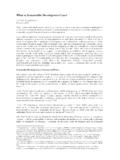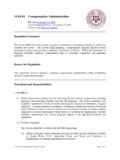Transcription of The Principle of Common But Differentiated ...
1 The Principle of Common But Differentiated Responsibilities: Origins and Scope For the World Summit on Sustainable Development 2002. Johannesburg, 26 August I. Definition of the Principle of Common but Differentiated Responsibilities The Principle of Common but Differentiated responsibility' evolved from the notion of the Common heritage of mankind' and is a manifestation of general principles of equity in international law. The Principle recognises historical differences in the contributions of developed and developing States to global environmental problems, and differences in their respective economic and technical capacity to tackle these problems. Despite their Common responsibilities, important differences exist between the stated responsibilities of developed and developing countries.
2 The Rio Declaration states: In view of the different contributions to global environmental degradation, States have Common but Differentiated responsibilities. The developed countries acknowledge the responsibility that they bear in the international pursuit of sustainable development in view of the pressures their societies place on the global environment and of the technologies and financial resources they command.. Similar language exists in the Framework Convention on Climate Change; parties should act to protect the climate system on the basis of equality and in accordance with their Common but Differentiated responsibilities and respective capabilities.. The Principle of Common but Differentiated responsibility includes two fundamental elements.
3 The first concerns the Common responsibility of States for the protection of the environment, or parts of it, at the national, regional and global levels. The second concerns the need to take into account the different circumstances, particularly each State's contribution to the evolution of a particular problem and its ability to prevent, reduce and control the threat. II. Implications of the Principle of Common but Differentiated Responsibilities In practical terms, the Principle has at least two consequences. First, it entitles, or may require, all concerned States to participate in international response measures aimed at addressing environmental problems. Second, it leads to environmental standards that impose differing obligations on States.
4 The Principle finds its roots prior to UNCED and is supported by state practice at the regional and global levels. Common responsibility describes the shared obligations of two or more States towards the protection of a particular environmental resource. Common responsibility is likely to apply where the resource is shared, under the control of no state, or under the sovereign control of a state, but subject to a Common legal interest (such as biodiversity termed a Common concern of humankind). The concept of Common responsibility evolved from an extensive series of international laws (see section III below) governing resources labelled as Common heritage of mankind' or of Common concern.'. Differentiated responsibility of States for the protection of the environment is widely accepted in treaty and other State practices.
5 It translates into Differentiated environmental standards set on the basis of a range of factors, including special needs and circumstances, future economic development of countries, and historic contributions to the creation of an environmental problem. The Stockholm Declaration emphasised the need to consider the applicability of standards which are valid for the most advanced countries but which may be inappropriate and of unwarranted social cost for the developing countries. In the Rio Declaration, states agreed that environmental standards, management objectives and priorities should reflect the environmental and developmental context to which they apply, that the special situation of developing countries, particularly the least developed and those most environmentally vulnerable, shall be given special priority, and that standards used by some countries may be inappropriate and of unwarranted economic and social cost to other countries, in particular developing countries.
6 Differential responsibility therefore aims to promote substantive equality between developing and developed States within a regime, rather than mere formal equality. The aim is to ensure that developing countries can come into compliance with particular legal rules over time thereby strengthening the regime in the long term. Practically speaking however, differential responsibility does result in different legal obligations. The techniques available in Differentiated responsibility include grace periods' or delayed implementation and less stringent commitments. In recent interpretation of WTO law, there is movement towards an obligation to consider the particular economic, social and environmental situation of developing countries when adopting environmental measures.
7 The WTO dispute settlement panel in the Shrimp case expressly mentioned the Principle of Common but Differentiated responsibilities in its conclusions. A particularly important aspect of the Principle is international assistance, including financial aid and technology transfer. As developed countries have played the greatest role in creating most global environmental problems, and have superior ability to address them, they are expected to take the lead on environmental problems. In addition to moving toward sustainable development on their own, developed countries are expected to provide financial, technological, and other assistance to help developing countries fulfil their sustainable development responsibilities.
8 In Agenda 21, developed countries reaffirmed their previous commitments to reach the accepted UN target of contributing of their annual gross national product to official development assistance. In summary, States have Common responsibilities to protect the environment and promote sustainable development, but due to different social, economic, and ecological situations, countries must shoulder different responsibilities. The Principle therefore provides for asymmetrical rights and obligations regarding environmental standards, and aims to induce broad State acceptance of treaty obligations, while avoiding the type of problems typically associated with a lowest Common denominator approach. The Principle also reflects the core elements of equity, placing more responsibility on wealthier countries and those more responsible for causing specific global problems.
9 Perhaps more importantly, the Principle also presents a conceptual framework for compromise and co-operation in effectively meeting environmental challenges. III. Manifestations of the Principle in Multilateral Treaties and Declarations Instances of Common responsibility appear as early as 1949, where tuna and other fish were described as being of Common concern to the parties by reason of their continued use by those parties. Other examples include outer space and the moon, on the other hand, aredescribed as the province of all mankind, waterfowl as an international resource, natural and cultural heritage as part of the world heritage of mankind as a whole, the conservation of wild animals as being for the good of mankind and resources of the seabed and ocean floor and subsoil as the Common heritage of mankind.
10 Recent state practice supports the emergence of the concept of Common concern as reflected in the Climate Change Convention, which acknowledges that change in the Earth's climate and its adverse effects are a Common concern of humankind, and the Biodiversity Convention which affirms that biological diversity is a Common concern of humankind. While each of these formulations differ, and must be understood and applied in the context of the circumstances in which they were adopted, the attributions of commonality share Common consequences. Although state practice is inconclusive as to the precise legal nature of each formulation, certain legal responsibilities are attributable to all States with respect to these environmental media and natural resources under treaty or customary law.







